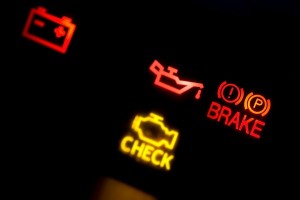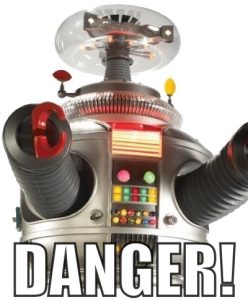Here’s the latest reader question, along with my reply!
Patrick asks: About check engine lights: I have one newer car and two older. With all three there is this check engine light that comes on from time to time. Reading the manual they recommend an immediate stop at your Toyota/Ford/Honda dealer. I would be very grateful to have the perspective from a knowledgeable auto person about how seriously these indicators should be taken. Someone told me it is a problem if the indicator light flashes. Sometimes the light comes on, occasionally it flashes, then it turns off again. There is no perceptible change in the behavior of the engines. All the fluids are fine and the cars are regularly maintained. If I visited a dealer every time a check engine light came on I would be a car dealership gypsy.
My reply: The “check engine” light – or malfunction indicator light (MIL) – generally lights at start-up, then (should) turn off after a few seconds, just like other warning lights in the gauge cluster. If it comes on and stays on, it means the OnBoard Diagnostics (OBD) system has registered a trouble code. The idea is to alert you to the need for service, which might be something very trivial – such as a gas cap that isn’t sealing properly. Or it could be a bad oxygen sensor, or some other issue.
Usually, it’s an emissions control-related issue.
Note that the light is yellow, not red. In other words, it is rarely a critical issue. Unlike, say, the red oil pressure indicator light. Which means – stop the car (and engine) right now!
Yellow lights just tell you to get it looked at when convenient.
Which you should do.
While it isn’t an emergency, running around with a bad oxygen sensor – a relatively cheap part – could over time result in damage to a more expensive part, like a catalytic converter.
But I get that going to the dealer is a hassle. And – of course – an expense. But there are ways around this.
First way: Many auto parts stores – Advance Auto, for instance – will check (and clear) trouble codes for free. They can also tell you what the code is – and means – so you’ll have the knowledge, in the event you decide to go to a dealer or mechanic to have whatever the issue is addressed. And it might be that all that needs “fixing” is a loose gas gap – or that you need a new gas cap. The MIL will trigger if the cap hasn’t been tightened properly, or a vapor leak is detected.
Second way: You can check – and clear – the OBD codes yourself. Every OBD-equipped car (since the mid-late ’90s) has a universal port, usually to the left of the steering wheel, under the dash, into which you plug scan tool. These are relatively inexpensive – $100 or so should buy you one that not only reads the codes but tells you what the codes mean – and much less expensive than several trips to the dealer.
Here is an article on this I wrote last year which you may find helpful.
It is very easy to use a scan tool – and a huge time/hassle saver if the MIL came on because of something like a loose or bad gas cap. Just clear the code, tighten (or replace) the gas cap – and you’re all set!
. . .
Got a question about cars – or anything else? Click on the “ask Eric” link and send ’em in!
If you like what you’ve found here please consider supporting EPautos.
We depend on you to keep the wheels turning!
Our donate button is here.
If you prefer not to use PayPal, our mailing address is:
EPautos
721 Hummingbird Lane SE
Copper Hill, VA 24079
PS: Get an EPautos magnet (pictured below) in return for a $20 or more one-time donation or a $5 or more monthly recurring donation. (Please be sure to tell us you want a sticker – and also, provide an address, so we know where to mail the thing!)
My latest eBook is also available for your favorite price – free! Click here. 












You can get a very basic scanner these days for about $25, that’ll just read the code(s); and for <$60 you can get a pretty good scanner that'll tell you a lot more, and run tests and show live data, etc. I got an Autel on Amazon for $53…it's amazing what it does! Not long ago, one would have had to spend $1500 or more to get a scanner that does as much as these cheapies do.
Every car owner should have a scanner. It'll pay for itself after the first use, even if you don't do your own repairs- just by letting you know what's going on, so the mechanic can't screw you- and not even to mention the convenience and time saved of not having to go somewhere to the code read.
I got my OBD2 reader at O’Reilly’s for $65. It doesn’t tell you anything but the code number(s) which you can easily look up online for your specific vehicle, and discover if anything really does need to be fixed and if so, you can usually find out how to do it. The one “problem” we had with our car engine was a $50 part that can be easily replaced in about 20 minutes, 15 minutes of which involves removing and replacing the air filter housing!
On most modern GM vehicles, there is an emissions vent that will always clog up if you drive off of paved roads. There really is no permanent fix other than to just keep clearing the damn code so the light will go off. Otherwise something might really go wrong and you won’t know it because the light is always on.
A basic OBD2 reader is absolutely indispensable if you own a 1996 or later vehicle. It is right up there with a jack and a spare tire. Before I *finally* bought my code reader, I paid a shop $35 extra to read the codes while in for an oil change. There were probably a hundred codes showing, all because the moron mechanic turned on the ignition and read the codes while the MAP sensor was still unplugged! I got my money back later but it was a big hassle, not the least of which was getting all that shit cleared and getting back to the original problem or non-problem triggering the light.
On my Fords, the flashing check engine light indicates a misfire in one of the cylinders. That may be Ford-specific, as on my Chevy a misfire does not flash the check engine light. YMMV
Regular misfire simply illuminates the MIL. A severe misfire causes the MIL to flash. It’s part of the OBD2 standard.